MINI Countryman PHEV
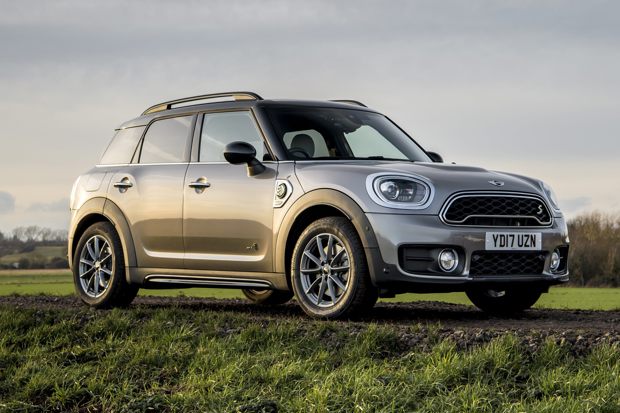

- New arrival: MINI Countryman Cooper S E All4 PHEV
- Our big MINI PHEV: what's it all about?
- 1,000-mile(ish) report: this MINI makes sense, somehow
- Drive modes in different area codes
- Big road test of BIG MINI [Pt.1]
- Big road test of BIG MINI [Pt.2]
- BIG MINI, big miles, big bills
- BIG MINI PHEV's charge sheet
- Does tax make this PHEV worthwhile?
- The joy of PHEV
- BIG MINI, why so glitchy?
New arrival: MINI Countryman Cooper S E All4 PHEV
Our big plug-in MINI has arrived. It's confusing and exciting in equal measure. Mark explains all...

Date: 24 October 2017 | Current mileage: 533 | Claimed economy: 134.5mpg | Actual economy: 60.1mpg
From the company famed for a very specific combination of smallness and self-declared ‘go kart handling’© comes this, a five-door crossover SUV with four-wheel drive courtesy of a fairly complex plug-in petrol-electric hybrid drivetrain.
Interesting, eh?
Aye, we have a MINI Countryman hybrid, or to use its proper name, a MINI COUNTRYMAN Cooper S E ALL4 PHEV. The caps annoy me too. We’ll just call it the ‘Countryman PHEV’ from now on. Or BIG MINI.
What to expect then? Well, what’s so fascinating about this car is that we really don’t know. I mean, most new cars are – if we’re bluntly honest – a largely known quantity before anyone’s turned the key (or pressed the button, more likely).

Driving off into the sunset. Well, an overcast sky anyway...
You know how it is: SEAT Arona…going to feel like a smaller Ateca, or a bigger Ibiza. Probably somewhere between the two. Volkswagen T-Roc: like a posher Arona. BMW X2: X1 meets X4. And so on.
But a MINI that’s maxi in size. And one with a Cooper badge but that also claims 135mpg? That’s a riddle wrapped in an enigma. A confusing company of contradictory concepts.
It also costs £44,000. Damn. Expectations raised. We’ll let you know how we get on. We’re genuinely intrigued – excited, even – by the prospect.
Our big MINI PHEV: what's it all about?
The MINI Countryman plug-in has a complicated and intriguing drivetrain. Here's the crack.
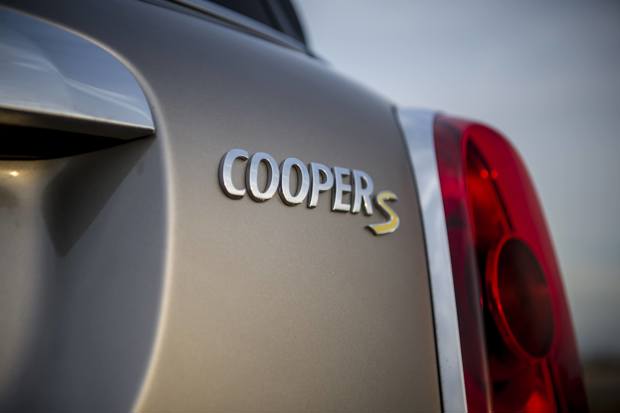
Date: 14 November 2017 | Current mileage: 822 | Claimed economy: 134.5mpg | Actual economy: 61.4mpg
Before getting into the pragmatic reality of running the BIG MINI, we should probably talk a bit about how it works and what it promises.
It’s powered by a plug-in petrol-electric hybrid drivetrain – one that gives it de facto all-wheel drive because the petrol engine turns the front axle and the electric motor the rear one. The power sources can each work alone or simultaneously, resulting in the unique – and occasionally bizarre, more of which later – reality of a car that’s both front and rear-wheel drive. It makes roundabouts more interesting, anyway.
MINI claims a 25-mile range from the electric motor alone, which has 88PS and, more importantly, 165Nm peak torque from standstill. For reference, a MINI One petrol hatchback gives you 102PS and 190Nm at 1350rpm.
Add the petrol motor – the three-cylinder unit found in the MINI Cooper, with 136PS and 220Nm – and you’ve got a combined output of 224PS and 385Nm. That’s enough to justify attaching a ‘Cooper S’ badge to the tailgate. The 0-62mph time justifies it too - 6.8 seconds.

This is the badge you get on a PHEV. Green...
The 0-62mph time also, no doubt, gives MINI license to call this Countryman “a sporty proposition” and such like. That’s paraphrased from a conversation I had with someone at the company, the subtext being “this is not an eco car, but a fun car that happens to be eco.”
The sub-subtext to that, I reckon, is “don’t expect any green miracles from this thing.” As you’ll discover in later updates, that’s a wise approach.
In fairness, that’s the case with all petrol-electric hybrids, as our Real MPG figures attest. To save you clicking the link, Britain’s best selling plug-in, the Outlander PHEV, manages 58% of its claimed 100mpg average.
If our MINI gets 58% of its claimed average I’ll be over the moon. Not literally. It will be 78mpg. BIG MINI’s official combined consumption rating is 134.5mpg. Never going to happen, surely.
1,000-mile(ish) report: this MINI makes sense, somehow
The first few weeks toing and froing with our big plug-in MINI is bringing much frugal enjoyment.
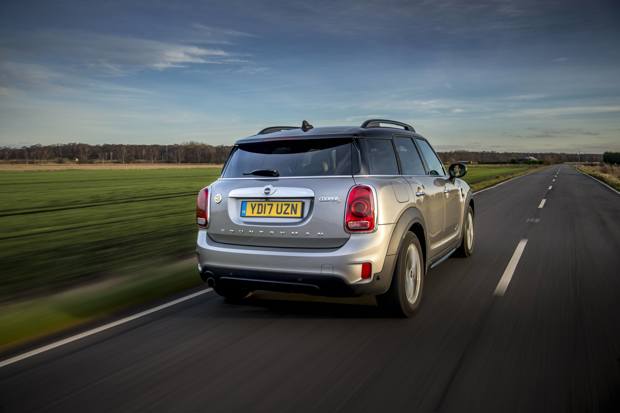
Date: 28 November 2017 | Current mileage: 1121 | Claimed economy: 134.5mpg | Actual economy: 62.2mpg
It’s been a few weeks with our expensive part-electric BIG MINI and it’s working out just dandy. It’s working out that way because it’s largely being used for the 20-odd-mile round trip to Mrs. Nichol’s place of work, which is just a little more than the range of the battery.
In the last update I postured that if BIG MINI could match the Mitsubishi Outlander PHEV’s Real MPG performance – 58% of its claimed average economy among drivers – that would be excellent. It would mean we’d get 78mpg.
We’re not getting that, but we are getting more than 60mpg and we’re pretty pleased. Our happiness comes with a significant caveat though because, again, BIG MINI isn’t really doing much more than that short-ish round trip. Usually, the battery runs out 4-5 miles before getting home. Ergo, 4-5 miles of fuel use per day.

Imagine having these three in your MINI Countryman at all times. That's MINI PHEV life.
And the plugging it in bit doesn’t really mater either, because it then ends up parked outside the house for the evening so it can fully charge for the next day. The upshot is, we’re rarely dipping into the tank and the MINI is making a lot of sense for us. I can see already, though, that life with it won’t remain this simple.
And actually, when you think about how few miles we’re doing, 62mpg isn’t that clever. I suppose that’s what happens when a three-cylinder petrol motor is dragging along 1735kg (plus me and that) on its own. For comparison, the BIG MINI Cooper, sans electric gubbins, weighs 1440kg. That’s 650lbs-odd extra in old money – three wrestlers in the car, at all times, in other words.
In conclusion then, so far so good, but I’m not convinced it’ll stay that way once BIG MINI’s remit expands a bit.
Drive modes in different area codes
The hybrid Countryman is part zero-emissions car, part hybrid hot hatch, depending where you are...
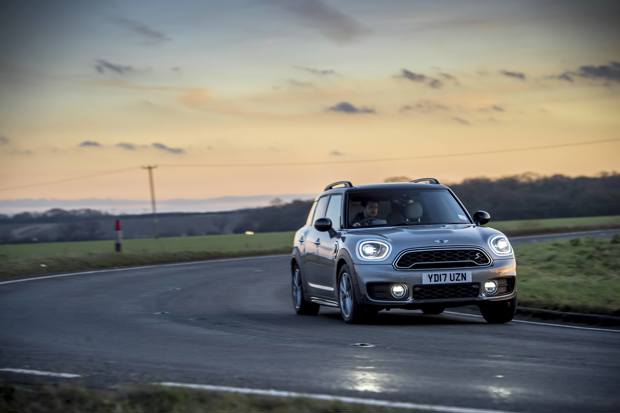
Date: 9 December 2017 | Current mileage: 1583 | Claimed economy: 134.5mpg | Actual economy: 58.7mpg
BIG MINI E has three drive modes: MAX eDRIVE, AUTO eDRIVE and SAVE. The first is its battery-only mode, within which BIG MINI is rear-wheel drive and capable of zero emissions driving at speeds up to 78mph – enough for everything, then.
And actually, in that mode the MINI does a sterling job of mimicking a full-time electric car. The petrol motor will kick in if you really hammer the throttle, but it takes some doing and in fact, there’s something about being in electric mode that positively encourages gentle driving anyway. Feels quite quick too, what with the whole maximum torque at zero rpm thing. 165Nm, that is.
It’s also mildly disconcerting – in a strangely amusing way, like – when the car begins to behave like the rear-wheel drive car it becomes.
With the MINI being on low rolling resistance tyres, with their inherently reduced grip, wet roundabouts become a different proposition. There aren’t many compact SUVs – any, I believe – that will lose grip from the rear like BIG MINI does in this circumstance.

Mark enjoying Radio 5 Live there
So far I’ve tried to drive in MAX eDRIVE (MINI LOVES ITS CAPITAL LETTERS) mode as much as possible, although it’s not actually that sensible at times – more of which in later updates.
AUTO eDRIVE, then, is fairly self-explanatory. The car will decide on the best power arrangement depending on how you’re driving. Drive gently - and with sufficient charge in the battery - and it defaults to as much electric-only driving as possible. Drive with more enthusiasm and the motor does most of the work, the electric motor relegated to being a sort of fancy turbocharger for the engine. eBOOST, or something.
It’s in this mode that BIG MINI is arguably at its most impressive, in that it near-imperceptibly switches from electric vehicle to fairly rapid twin-engined crossover. With a fully charged electric motor boosting the petrol motor, the Countryman does feel pretty rapid. Indeed, 0-62mph happens in 6.8 seconds.
Finally, SAVE mode. It retains the electric motor’s battery, only using the petrol motor so that you can have a few miles zero-emission driving later on, for whatever reason. I’ve not used it. Probably won't bother either.
Big road test of BIG MINI [Pt.1]
We've had our big hybrid MINI for a while now, so if you're after a road test, here's the first half of one.
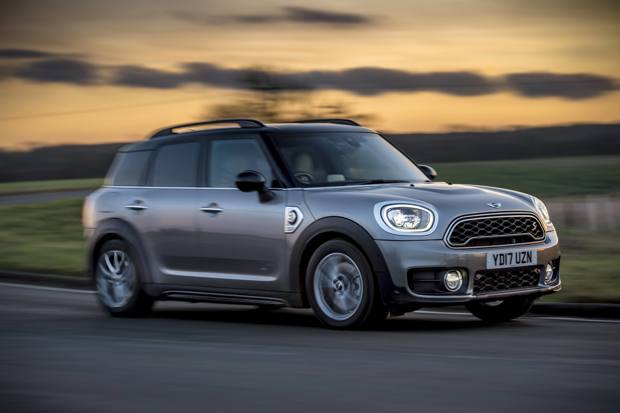
Date: 22 December 2017 | Current mileage: 2154 | Claimed economy: 134.5mpg | Actual economy: 56mpg
A few updates ago we mentioned that a MINI person intimated that the Countryman Cooper S E is as much a ‘sporty’ crossover as it is an ‘eco’ one. (Quotations denote general cynicism about both concepts as applied to cars – especially SUV type ones.)
That’s quite a big claim; I’ve only ever driven one hybrid that was genuinely enjoyable – the BMW i8.* And even that is only fully enjoyable for the brief time that the battery isn’t flat, and is always in the dynamic shadow of the Audi R8.
The rest of them suck. They usually have CVT gearboxes, usually sound terrible, usually feel heavy.
So I’m pleased to announce that this one doesn’t. BIG MINI is, by a mile, the most enjoyable PHEV to drive this side of an i8. Same caveat though – when the battery’s flat it’s pretty poor – heavy, noisy, slow. But assuming the battery is full there’s a nice synergy to the way this drivetrain works. It’s quick and clever, but serves up about the most conventional driving experience you could hope for from one of these.
It doesn’t have a CVT for a start, so there’s no whiney, droning din as the gear cones settle on the most efficient engine speed. It sounds ok too – that’ll be the three-cylinder growl – and although there’s no doubting this is a heavy car, it does feel quick when both engines are working together properly.

And because it’s a MINI, it steers well. Lots of weight to the steering rack coupled with a nice sharpness to the turn in. The low rolling resistance tyres mean it breaks grip a little earlier than you’d probably like, but given how complicated the drivetrain is (one engine driving the front axle, another the rear), it’s a surprisingly well-balanced car.
Unsurprisingly, though, the ride quality is occasionally poor. MINIs are always set up on the firm side as it is, so add the extra weight of the electric motor and the additional damping firmness required to compensate, and BIG MINI can be a jarring. Could be a lot worse, though, and it’s set up in a manner befitting a car badged Cooper S.
In fact, I’d probably go as far as to say it’s one of the most enjoyable medium crossover things (Qashqai, Ateca etc) to drive – certainly it’s the one that plugs you in most convincingly.
And on that god-awful pun I’ll leave it. Part two shortly. It’s not great news.
*Note: since writing this I've made a video about the Honda NSX, doubling the amount of geniunely enjoyable hybrids I've ever driven. Click here to watch that.
*Other note: I briefly forgot about the Peugeot 3008 when writing the penultimate paragraph, but to mention it would ruin the ending. So I'll say it now - the Peugeot 3008 is the best family crossover to drive.
Big road test of BIG MINI [Pt.2]
We've established that BIG MINI electric is fun to drive, but unfortunately it's also a very flawed long distance car.
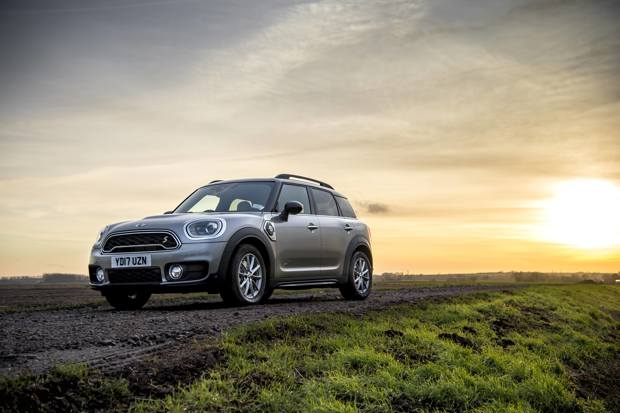
Date: 11 January 2018 | Current mileage: 2662 | Claimed economy: 134.5mpg | Actual economy: 56.5mpg
In the last update we explained that, despite having inordinately complicated underneath bits, the MINI is perhaps the most engaging medium crossover behind the wheel – yep, even the PHEV one.
In a few other ways, however, it’s scandalously frustrating. And that’s before you’ve framed it as a £44,000 car. That’s right. Just let that sink in. This fat MINI costs £44,000. We’ll go into detail about that in the next update, but it’s worth keeping in mind for now. You know, because you could just about scrape into a base model Porsche Macan for that.
Firstly - and by far the most irritating thing about our Countryman - is wind noise. Beyond 60mph or so it really does feel like there’s a gap in the windows. I think it’s coming from the edges of the sunroof (panoramic, optional, £800), but it’s so bad that I think there might be something wrong with the seals – I can’t believe that MINI (BMW) would have passed it that way. The din in the cabin is, frankly, atrocious.
It ruins the MINI as a long distance car, because there’s actually a good load of tyre noise too, and because the ride is on the firm side and the seats are too, it’s just not that pleasant to do distances in.

The bit where Mark's legs go
Couple that to the fact that, we’re discovering, long distance fuel economy is poor and the fuel tank is tiny – 36 litres – and this is not a car for high mileage drivers.
Not at all. We’ll talk more about fuel economy at a later date, but for now we’ll say that any initial glee at BIG MINI’s short distance efficiency is being well and truly eroded with every motorway excursion.
It’s a shame, because BIG MINI has a fantastic driving position – comfortable, lots of adjustment – and good visibility, so the basic ingredients of a quality motoway car are there. Plenty of overtaking power too. But in reality, on the motorway it feels lke a small car - noisy, unsettled. There’s irony in there somewhere.
So, great at the round the doors stuff, not so great further afield – is that really acceptable for £44,000 worth of family SUV crossover?
BIG MINI, big miles, big bills
Our Countryman PHEV isn't giving us anywhere near the economy it should be. It's getting frustrating.

Date: 25 January 2018 | Current mileage: 2825 | Claimed economy: 134.5mpg | Actual economy: 56.2mpg
Early days with the MINI were an absolute joy. We were rarely dipping into the tank during the 20-mile(ish) round trip it was doing daily and so it seemed, in a purely pragmatic, non-scientific way, a highly economical, highly sensible experience.
Then we started taking the car further afield – trips from Newcastle to the HJ office in Northamptonshire, for instance. The contrast was jarring.
Here’s an example. Recently during a journey from the office back home, when the car hadn’t been charged beforehand, we used 27.01 litres of fuel doing 198.3 miles. All but five miles or so was on the motorway, and at sensible, cautious pace. (Honestly.)
That means we used 5.94 gallons, which means our economy was 33.38mpg. I know, right. Absolutely brilliant…hang on.

The MINI PHEV doing its thing
See, on the motorway the whole PHEV concept falls apart here, because in anyone’s book, 33mpg for a gentle motorway journey in a three-cylinder petrol car is awful. We’ve flipped convention on its head here. Normal petrol or diesel cars are at their most efficient on the motorway, generally. BIG MINI is at its worst.
Things slightly improve when the car’s charged. Same journey going the other way a few weeks later, for example – from home to the office, after BIG MINI had been plugged in overnight – gave us 35.8mpg. Hardly a leap though, right.
Plus, with the fuel tank being just 36 litres it means we’re constantly filling the thing up. There’s something in that too – of course, the fuel bills aren’t huge (£40 a pop seems reasonable these days), but being at the pumps so regularly contributes to the feeling of being financially drained.
And so, again, that this is not a car for those who spend the majority of their time on the motorway. For a few good reasons.
BIG MINI PHEV's charge sheet
As the temperature drops so too does the MINI's battery range, and so too does overall fuel economy...

Date: 8 February 2018 | Current mileage: 2993 | Claimed economy: 134.5mpg | Actual economy: 51.5mpg
When BIG MINI first arrived we considered having a fast charger fitted to the house. There’s a Government grant for it and everything: 75% of the cost, capped at £500, which, coincidentally, is about how much it costs to have one installed. Weird, that.
Long story short, we needed to prove that we’d have the car for six months – the minimum ownership period required to qualify the grant – and for various reasons we weren’t able to do that. So, unfortunately, this time around we won’t be able to tell you what difference it makes having a fast charger.
Saying that, we pretty much know what difference it will make – it’ll reduce the time to charge the car from around eight hours to two and a half hours. Additional convenience, yes, but to us it doesn’t seem to make much difference – the car is away during the day, then left to charge overnight. Via a cable that runs into the garage. The same thing our next door neighbours do with their Nissan Leaf.
Of course, there are occasions – weekends usually – when having a 2.5-hour charge time would be handy, and frankly if we owned the car we’d certainly be investing in a charge box.

Here's what owning a £44,000 petrol-electric hybrid car looks like. Pure glamour.
Anyway, whichever way it's dispensed, a full charge will give you "up to 25 miles", says MINI. It's the sort of claim that shops make during the sales. “UP TO 70% OFF!” they scream, which of course could mean 1% off, which is a number in the ‘up to 70%’ range.
And so it is with the MINI, which started off giving us 18-20 miles of electric driving, but as the winter has come and the temperature has dropped, it’s now closer to 15. So we’re dipping into the tank more on shorter journeys with a flat battery, which is dragging down our short-distance economy.
In fairness, 50mpg-plus is very good for such a big car – and it’s that which we should focus on, really – but it’s hard not to see it in the context of the claimed 134.5mpg. And the list price. And a standard diesel engine.
There’s the tax thing to think about, of course, but we’ll do that next time.
Does tax make this PHEV worthwhile?
Our Countryman isn't giving us anywhere near its claimed mpg - obviously - but what if you're a company car driver?

Date: 22 February 2018 | Current mileage: 3114 | Claimed economy: 134.5mpg | Actual economy: 51.7mpg
If you’ve got a BIG MINI PHEV – or are thinking about getting one – chances are you’re picking it from a list as a company car. My guess is that MINI isn’t selling many of its £33,000 Qashqai rival in the showrooms.
As a company car proposition it looks very appealing indeed. Compare it to a similarly sized, similarly premium (arguably), conventionally engined SUV – an Infiniti QX30, say – and you’ll probably agree.
The left column is a base model Infiniti QX30 2.0t petrol, and on the right our BIG MINI. You’ll note the similarity between the P11D prices and, of course, the vast tax difference. Fairly self-explanatory.
As we’ve already discussed, if you’re a low mileage sort of driver – as in, 15 to 20 miles per day - then the PHEV could work very well in your favour. Beyond that – as we’ve also already discussed – things can fall apart quite dramatically.

Of course the other, under-reported, element of this is the cost of driving using the battery – it might feel ‘free’ but it obviously isn’t. The problem is that it’s not quite as easy to quantify as good old mpgs.
For a start, tariffs vary both by geography and time, but also, units of electrical energy consumption are still quite alien to most people in car terms. As someone who pays zero attention to his energy bills (not because of socio-economic privilege, but because they’re boring and they tend to work themselves out) I count myself in that alienated category.
Still, this should be fairly simple. The capacity of the MINI’s electric motor battery is 7.6kWh. So, let’s assume a fairly high average electricity tariff of 15p per kWh (yours is probably closer to 12p), and the cost per charge is £1.14. And assuming an average 15 electric-only miles from a charge – about right in our experience – we’re back to 7.6 again: 7.6p per mile.
Compare that, then, to what it costs using the petrol engine to power our car. Again, some assumptions are required. So, let’s take the 27 litres it took us to drive 198 miles from the office a few weeks back, with an empty battery, and that the fuel cost is £1.20 per litre. That’s £32.40. Which means it cost 16.4p per mile in fuel to get up the motorway.
Draw your own conclusions on what all this could mean in your own circumstances. But, it does seem that if you’re in the particular position of being able to pick a £35-40,000 company car but don’t fancy a diesel Audi like everyone else, and you live very close to work and are rarely on the motorway, this could very well work for you. For everyone else…
The joy of PHEV
In cold statistical terms, BIG MINI works very well for some and not so for others - but there's joy for all in the cabin.
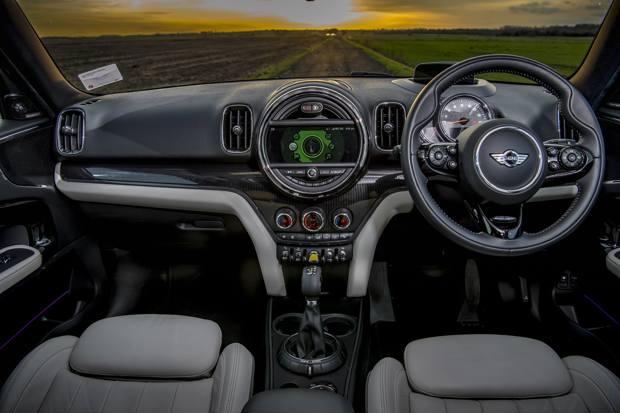
Date: 8 March 2018 | Current mileage: 3439 | Claimed economy: 134.5mpg | Actual economy: 51.5mpg
It occurs to me that I’ve spent a lot of time talking about the finer details of PHEV ownership and the things that have annoyed or disappointed me about BIG MINI. But actually, there’s a lot that I really like about this car – and, arguably more importantly, that the kids do.
For a start there’s nothing quite like this car. Think what you like about the whole BIG MINI concept, but in execution there’s no other medium sized SUV crossover thing with this much personality. Even if you hate it, that sort of proves the point.
The kids have picked up on this (they’re 8 and 10), and the younger of the two, my daughter, especially loves the MINI. Granted, a lot of it is to do with this car’s predecessor in our household, an Audi A5. They hated that, obviously – two doors, 6'4" dad and so on. The arguments about who sat behind me were constant.
So the space that the MINI affords is freedom to them. And it really is spacious. I’ve not talked about that at all yet. This is a proper five-seat car, but more than that, it’s actually quite small with it. It’s packaged well – small enough to feel compact and maneuverable on the road, but with proper interior space.

Beige. Like a pensioner's trousers...
The beige leather upholstery is beautiful too, right down to the details of the stitching and the two-tone asymmetry of the door cards is nice little detail. The kids love the dashboard lights too – which includes neon pinstripe illumination of the majority of the passenger side trim. Sounds cheesy and rubbish, but in the MINI it works really well.
Changing the colour of the lights is a fun thing to do now – we all tend to agree on it. in the last MINI I had, a couple of years ago, it caused no end of arguments. Mainly whose turn it was to choose the colour and what it should be. (The lights cylcle their colours at night if a door is open too - another cool, if slightly pointless, feature.)
And then there’s just the look of the thing from the inside. I still have a real soft spot for MINI interior design. It’s fun: the toggle switches, the massive screen, the sense of quality, the lights. At a time when every new car seems to be a crossover of some sort - and they’re all starting to look largely the same and not that interesting - BIG MINI’s idiosyncrasies are very welcome.
Finally there's the boot, which at 405 litres is 45 down on a regular BIG MINI's (because of the battery and what have you), but is still more than big enough for family duties. Plus the loading floor is high and flat by default, and the rear bench splits 40/20/40. On a basic level, it's just a lovely family car. Interesting and practical.

Behold! BIG MINI boot holds many things.
BIG MINI, why so glitchy?
An unexpected late night knock at the door starts the latest chapter in the MINI's odd behaviour…
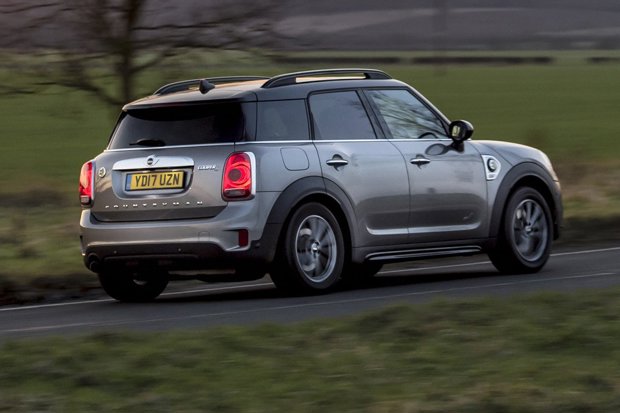
Date: 22 March 2018 | Current mileage: 3717 | Claimed economy: 134.5mpg | Actual economy: 51.2mpg
It's 11pm on a Sunday night. I’m in bed, very nearly asleep. Knock at the door. I must be dreaming. Who’d be knocking at the door now? I roll over.
Knock, knock, KNOCK.
Damn. Jump up, clothes on, downstairs. I don’t know why I always assume it’s a psychopathic murderer politely knocking on the door late at night, but I do. I blame Netflix.
Whatever. Open the door.
“Do you know your boot is wide open?”
“Is it? Oh bloody hell. Thanks for letting me know.”
“You’re welcome. I just thought it was a bit strange because all your house lights are off.”
What a lovely old lady. I thank her profusely, put the crow bar down, go out and confirm that, yes, BIG MINI’s boot is wide open. It was definitely closed when I left it a couple of hours earlier.

Toggles. Lots of toggles.
It all started at the pumps. I was stood there, filling up and thinking about the Queen, when the boot opened. All by itself. ‘That’s weird’, I thought, but the key was in my pocket and I was daydreaming, so maybe I pressed it by accident? (You can open the automatic tailgate with the key, in case that wasn’t clear.)
Couple of weeks later, happened again. This time I know I hadn’t pressed the key. I mentioned it to our Nicola. “Oh yeah, that’s happened to me too!”
So, BIG MINI likes to open its boot when it’s being filled up. And, it seems, when it’s parked outside the house. It’s very embarrassing because, this being a family motor, the boot is usually full of…well, ****. So when there’s someone behind waiting to fill up, they see all that ****. And they also see you mutter “for ****’s sake” before closing the boot, mid fill-up.
But that’s not the only glitch. More worryingly (despite the fact that I’m about to give it a tenth of the column space of the boot stuff), the car cut out once, after I pressed the drive mode toggle.
Plus, the cruise control does what it wants – quite often it’ll just stop working and give me some message about being non-operational – and the Bluetooth doesn’t like hooking up to my phone, also arbitrarily.
The upshot: my trust in BIG MINI is eroding. It’s not unusual to lack faith in an ancient runabout or something French, but it is unusual to start losing faith in £44,000 worth of brand new BMW. Weird.
